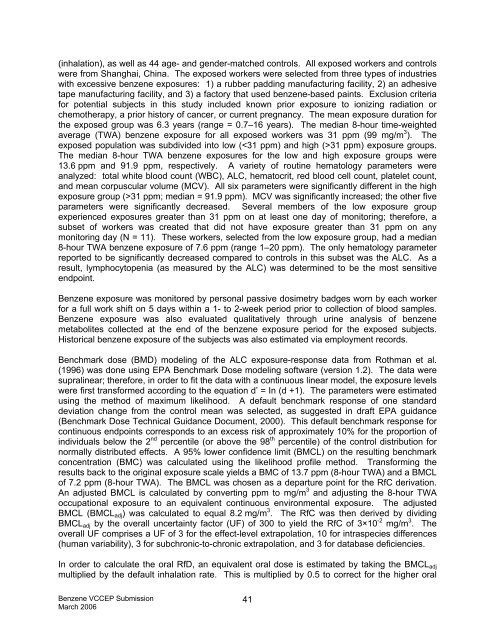(VCCEP) Tier 1 Pilot Submission for BENZENE - Tera
(VCCEP) Tier 1 Pilot Submission for BENZENE - Tera
(VCCEP) Tier 1 Pilot Submission for BENZENE - Tera
You also want an ePaper? Increase the reach of your titles
YUMPU automatically turns print PDFs into web optimized ePapers that Google loves.
(inhalation), as well as 44 age- and gender-matched controls. All exposed workers and controls<br />
were from Shanghai, China. The exposed workers were selected from three types of industries<br />
with excessive benzene exposures: 1) a rubber padding manufacturing facility, 2) an adhesive<br />
tape manufacturing facility, and 3) a factory that used benzene-based paints. Exclusion criteria<br />
<strong>for</strong> potential subjects in this study included known prior exposure to ionizing radiation or<br />
chemotherapy, a prior history of cancer, or current pregnancy. The mean exposure duration <strong>for</strong><br />
the exposed group was 6.3 years (range = 0.7–16 years). The median 8-hour time-weighted<br />
average (TWA) benzene exposure <strong>for</strong> all exposed workers was 31 ppm (99 mg/m 3 ). The<br />
exposed population was subdivided into low (31 ppm) exposure groups.<br />
The median 8-hour TWA benzene exposures <strong>for</strong> the low and high exposure groups were<br />
13.6 ppm and 91.9 ppm, respectively. A variety of routine hematology parameters were<br />
analyzed: total white blood count (WBC), ALC, hematocrit, red blood cell count, platelet count,<br />
and mean corpuscular volume (MCV). All six parameters were significantly different in the high<br />
exposure group (>31 ppm; median = 91.9 ppm). MCV was significantly increased; the other five<br />
parameters were significantly decreased. Several members of the low exposure group<br />
experienced exposures greater than 31 ppm on at least one day of monitoring; there<strong>for</strong>e, a<br />
subset of workers was created that did not have exposure greater than 31 ppm on any<br />
monitoring day (N = 11). These workers, selected from the low exposure group, had a median<br />
8-hour TWA benzene exposure of 7.6 ppm (range 1–20 ppm). The only hematology parameter<br />
reported to be significantly decreased compared to controls in this subset was the ALC. As a<br />
result, lymphocytopenia (as measured by the ALC) was determined to be the most sensitive<br />
endpoint.<br />
Benzene exposure was monitored by personal passive dosimetry badges worn by each worker<br />
<strong>for</strong> a full work shift on 5 days within a 1- to 2-week period prior to collection of blood samples.<br />
Benzene exposure was also evaluated qualitatively through urine analysis of benzene<br />
metabolites collected at the end of the benzene exposure period <strong>for</strong> the exposed subjects.<br />
Historical benzene exposure of the subjects was also estimated via employment records.<br />
Benchmark dose (BMD) modeling of the ALC exposure-response data from Rothman et al.<br />
(1996) was done using EPA Benchmark Dose modeling software (version 1.2). The data were<br />
supralinear; there<strong>for</strong>e, in order to fit the data with a continuous linear model, the exposure levels<br />
were first trans<strong>for</strong>med according to the equation d’ = In (d +1). The parameters were estimated<br />
using the method of maximum likelihood. A default benchmark response of one standard<br />
deviation change from the control mean was selected, as suggested in draft EPA guidance<br />
(Benchmark Dose Technical Guidance Document, 2000). This default benchmark response <strong>for</strong><br />
continuous endpoints corresponds to an excess risk of approximately 10% <strong>for</strong> the proportion of<br />
individuals below the 2 nd percentile (or above the 98 th percentile) of the control distribution <strong>for</strong><br />
normally distributed effects. A 95% lower confidence limit (BMCL) on the resulting benchmark<br />
concentration (BMC) was calculated using the likelihood profile method. Trans<strong>for</strong>ming the<br />
results back to the original exposure scale yields a BMC of 13.7 ppm (8-hour TWA) and a BMCL<br />
of 7.2 ppm (8-hour TWA). The BMCL was chosen as a departure point <strong>for</strong> the RfC derivation.<br />
An adjusted BMCL is calculated by converting ppm to mg/m 3 and adjusting the 8-hour TWA<br />
occupational exposure to an equivalent continuous environmental exposure. The adjusted<br />
BMCL (BMCLadj) was calculated to equal 8.2 mg/m 3 . The RfC was then derived by dividing<br />
BMCLadj by the overall uncertainty factor (UF) of 300 to yield the RfC of 3×10 -2 mg/m 3 . The<br />
overall UF comprises a UF of 3 <strong>for</strong> the effect-level extrapolation, 10 <strong>for</strong> intraspecies differences<br />
(human variability), 3 <strong>for</strong> subchronic-to-chronic extrapolation, and 3 <strong>for</strong> database deficiencies.<br />
In order to calculate the oral RfD, an equivalent oral dose is estimated by taking the BMCLadj<br />
multiplied by the default inhalation rate. This is multiplied by 0.5 to correct <strong>for</strong> the higher oral<br />
Benzene <strong>VCCEP</strong> <strong>Submission</strong><br />
March 2006<br />
41





